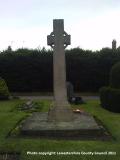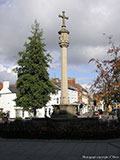Able Bodied Seaman John Robert Clifford Granger, RFR/PO/B/2563
- Batt -
- Unit - Royal Navy
- Section - HMS Good Hope
- Date of Birth - 31/03/1884
- Died - 01/11/1914
- Age - 30
Add to this record?
If you have photographs, documents or information that can contribute to this record, you can upload here
ContributeSource: Michael Doyle Their Name Liveth For Evermore: The Great War Roll of Honour for Leicestershire and Rutland. He was the son of Joseph Granger, a signalman, born 1857 in Northamptonshire and his wife Sarah Ann Granger (nee Clifford, married in the 2nd quarter of 1883 in the Market Harborough, Leicestershire district), born 1857 in East Farndon, Northamptonshire. John Robert Clifford, a schoolboy, was born on the 31st March 1884 in Melton Mowbray, Leicestershire, his siblings were, Lucy Frances, a schoolgirl, born 1886 and Francis Joseph, born 1889, both his siblings were born in Melton Mowbray, Leicestershire, in April 1891 the family home was at Station Road, Hallaton, Leicestershire. In April 1901 John was absent from the family home at 68, Stanley Street, Kingsthorpe, Northamptonshire, residing there was his mother and siblings, Francis, Herbert William, born 1891 in Hallaton, Leicestershire, Leonard George, born 1893 and Edward James, born 1896, the latter two siblings were both born in Little Bowden, Northamptonshire, John was serving as a Boy 2nd Class with the Royal Navy. In April 1911 John was employed as a postman and was residing in the family home at 14, Bellfield Street, Little Bowden, Northamptonshire, together with his wife Elizabeth Granger, born 1881 in Little Houghton, Northamptonshire, and their children, Leonard, a schoolboy, born 1901 and Joseph, born 1910, both the children were born in Little Bowden, Northamptonshire. His younger brother Herbert also died. John enlisted into the Royal Navy to serve a 12 year engagement on the 7th March 1900, his reckonable service to commence on the 31st March 1902, and he was allocated the service number 208749 in Portsmouth, Hants. His medical examination recorded that he was 5 foot 4¾ inches in height, he had dark brown hair and his eyes were brown, his complexion was described as dark, he gave his trade or calling as baker. Upon re-examination when he attained the age of 18 years, he was recorded as 5 foot 7 inches in height. His record of service began when he joined HMS Ganges as a Boy 2nd Class on the 7/3/00 – 21/11/00, when he was promoted to Boy 1st Class. HMS Ganges, 22/11/00 – 9/5/01. HMS Minotaur, 10/5/01 – 20/6/01. HMS Ganges, 21/6/01 – 27/8/01. HMS St. Vincent, 28/8/01 – 19/10/01. HMS Minotaur, 20/10/01 – 5/11/01. HMS Agincourt, 6/11/01 – 24/11/01. HMS Vernon, 25/11/01 – 30/3/02, when he was promoted to Ordinary Seaman. HMS Vernon, 31/3/02 – 7/4/02. HMS Vengeance, 8/4/02 – 6/6/02. HMS Cruiser, 7/6/02 – 19/7/02. HMS Vengeance, 20/7/02 – 11/9/03, when he was promoted to Able Bodied Seaman. HMS Vengeance, 12/9/03 – 4/12/04. HMS Excellent, 5/12/04 – 20/5/05. HMS Victory I, 21/5/05 – 23/5/05. HMS Enchantress, 24/5/05 – 30/6/05. HMS Victory I, 1/7/05 – 7/7/05. HMS Enchantress, 8/7/05 – 28/5/06. HMS Venus, 29/5/06 – 22/3/08, HMS Victory I, 23/3/08 – 28/3/08, when on the 16th March 1908 he applied to purchase his discharge, and joined the Royal Fleet Reserve on the 29th March 1908 and was allocated the service number RFR/PO/B2563 in Portsmouth, Hants. John was recalled from the Royal Fleet Reserve and re-joined HMS Good Hope as an Able Bodied Seaman on the 13/7/14 – 24/7/14. HMS Victory I, 25/7/14 – 30/7/14. HMS Good Hope, 31/7/14 – 1/11/14, when he lost his life at the Battle of Coronel. The background leading to the circumstances in which John lost his life is as follows. HMS Good Hope rendezvoused with the rest of the squadron at Vallenar Roads in the remote Chonos Archipelago of Chile on 27th October to re-coal. They departed two days later, just as HMS Canopus arrived, Cradock ordering the battleship to follow as soon as possible. He sent the light cruiser HMS Glasgow to scout ahead and to enter Coronel, Chile to pick up any messages from the Admiralty and acquire intelligence regarding German activities. The cruiser began to pick up German radio signals from the light cruiser SMS Leipzig on the afternoon of 29th October, and delayed entering Coronel for two days with Cradock’s permission to avoid being trapped by the fast German ships. A German supply ship was already there and radioed Spee that Glasgow had entered the harbour around twilight. The cruiser departed on the morning of 1st November, but Spee had already made plans to catch her when informed of her presence the previous evening. HMS Glasgow departed Coronel at 9.15 am after having picked up the squadron's mail and rendezvoused with the rest of the squadron four hours later. Cradock ordered his ships to form line abreast with a distance of 15 nautical miles (17 miles) between ships to maximize visibility at 1.50 pm, and steered north at a speed of 10 knots (12 mph). At 4.17 pm SMS Leipzig spotted Glasgow, the easternmost British ship, to its west and she spotted SMS Leipzig’s funnel smoke three minutes later. At 5.10 pm Cradock ordered his ships to head for HMS Glasgow, the closest ship to the Germans. Once gathered together, he formed them into line astern, with HMS Good Hope in the lead, steering southeasterly at 16 knots (18 mph) at 6.18 pm. As the sixteen 8.3 inch guns aboard the armoured cruisers Scharnhorst and Gneisenau were only matched by the two 9.2 inch guns on his flagship, he needed to close the range to bring his more numerous 6 inch guns to bear. The Force 7 winds and high seas, however, prevented the use of half of those guns as they were too close to the water. He also wanted to use the setting sun to his advantage so that its light would blind the German gunners. Spee was well aware of the British advantages and refused to allow Cradock to close the range. His ships were faster than the British, slowed by the 16 knot maximum speed of the armed merchant cruiser Otranto, and he opened up the range to 18,000 yards until conditions changed to suit him. The sun set at 6.50 pm, which silhouetted the British ships against the light sky while the German ships became indistinguishable from the shoreline behind them. Spee immediately turned to close and signaled his ships to open fire at 7.04 pm when the range closed to 12,300 yards. Spee’s flagship, Scharnhorst, engaged HMS Good Hope while Gneisenau fired at HMS Monmouth. Cradock’s flagship was hit on the Scharnhorst’s third salvo, when shells knocked out her forward 9.2 inch turret and set her forecastle on fire. Cradock, knowing his only chance was to close the range, continued to do so despite the battering that Spee’s ships inflicted. By 7.23 pm the range was almost half of that when the battle began and the British ships bore onwards. Spee tried to open the range, fearing a torpedo attack, but the British were only 5,500 yards away at 7.35 pm. Seven minutes later, HMS Good Hope charged directly at the German ships, although they dodged out of her way. Spee ordered his armoured cruisers to concentrate their fire on the British flagship and drifted to a halt with her topsides all aflame. At 7.50 pm her forward magazine exploded, severing the bow from the rest of the ship, and she later sank in the darkness. Spee estimated that his flagship had made 35 hits on HMS Good Hope, suffering only two hits in return that did no significant damage and failed even to wound one crewman. HMS Good Hope was sunk with all hands, a total of 919 officers and enlisted men. Four of the midshipmen aboard the ship were the first casualties of the newly formed Royal Canadian Navy.
On Friday November 20th 1914 The Leicester Journal published the following article under the heading. “THE ROLL OF HONOUR.” – A Market Harborough postman, Mr. J. Grainger, is believed to have been on H.M.S. Good Hope sunk off Chile. His wife and two little children live at Bath-street, Market Harborough.
On Saturday November 21st 1914 The Leicester Chronicle and Leicestershire Mercury published the following article under the heading. “FOUR MEN FROM MARKET HARBOROUGH.” – Mr. J. Spriggs, of 22, Bath Street, Market Harborough, has received information that his son, Private Geo. Spriggs, of the 1st Leicester’s, has been killed in action in France. A Market Harborough postman, Mr. J. Grainger is believed to have been on H.M.S. Good Hope sunk off Chile. His wife and two little children live at Bath Street, Market Harborough. Mr. and Mrs. G. T. Stokes, of Drayton, Market Harborough, have lost both their sons. One of them, Arthur, was on the Good Hope, and the other Edgar, of the 1st Northampton’s, has been killed near Ypres by a bullet wound through the chest.
Source: Leicestershire War Memorials Project. John lived in Hallaton as a child when his father was a signal man at Hallaton Station. On leaving school he worked as a baker. Seeking a more adventurous life, on 31st March 1902 he enlisted for 12 years in the Royal Navy and trained at HMS Ganges, the Naval Training Establishment at Harwich. He then served on board numerous ships on the Mediterranean and China stations as well as on board HMS Victory. On 28th March 1908 he purchased his release from the rest of his engagement and was required to join the Royal Naval Reserve. He returned to the Welland Valley and married Elizabeth Anne Whinney, living in Little Bowden. Employed as a postman, the family moved in 1912 to Bath Street, Market Harborough. With the threat of war looming, John was recalled as a naval reservist and assigned to HMS Good Hope as an Able Seaman. She sailed on 2nd August 1914 en route to Halifax, Nova Scotia then was ordered to steam to the South Atlantic station to protect British shipping from German raiders. On 1st November 1914 having joined up with HMS Glasgow and HMS Monmouth, they were off the southern coast of Chile when they met the German fleet commanded by Admiral von Spee. Hopelessly outgunned, HMS Good Hope was sunk within half an hour, HMS Monmouth some two hours later with the loss of 1418 British lives in what is known as the Battle of Coronel. He is commemorated on:-
- Portsmouth Naval Memorial
- Cottage Hospital Memorial, Market Harborough
- Town Square Memorial, Market Harborough
- St Nicholas Churchyard, Little Bowden
Information (including photograph) kindly provided by Dennis Kenyon.
- Conflict - World War I
- Unit - Royal Navy
- Former Unit n.o - 208749
- Former Unit - Royal Navy
- Cause of death - KILLED IN ACTION
- Burial Commemoration - Portsmouth Naval Mem., Hants., England
- Born - Melton Mowbray, Leicestershire
- Enlisted - 07/03/1900 In Portsmouth, Hampshire
- Place of Residence - 23 Bath Street, Market Harborough, Leicestershire, England
- Memorial - ST. NICHOLAS'S CHYRD. MEM., LITTLE BOWDEN, NORTHANTS
- Memorial - MARKET HARBOROUGH MEM., LEICS
- Memorial - ST. HUGH'S CHURCH, MARKET HARBOROUGH, LEICS
- Memorial - COTTAGE HOSPITAL WAR MEM., MARKET HARBOROUGH, LEICS



